
A reef aquarium or reef tank is a marine aquarium that prominently displays live corals and other marine invertebrates as well as fish that play a role in maintaining the tropical coral reef environment. A reef aquarium requires appropriately intense lighting, turbulent water movement, and more stable water chemistry than fish-only marine aquaria, and careful consideration is given to which reef animals are appropriate and compatible with each other.
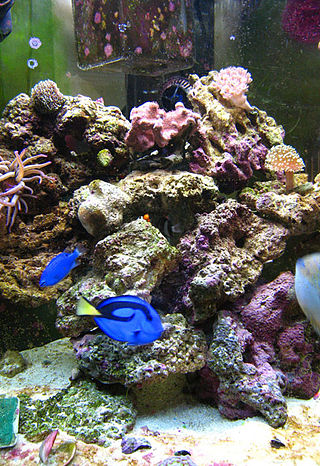
A marine aquarium is an aquarium that keeps marine plants and animals in a contained environment. Marine aquaria are further subdivided by hobbyists into fish only (FO), fish only with live rock (FOWLR), and reef aquaria. Fish only tanks often showcase large or aggressive marine fish species and generally rely on mechanical and chemical filtration. FOWLR and reef tanks use live rock, a material composed of coral skeletons harboring beneficial nitrogen waste metabolizing bacteria, as a means of more natural biological filtration.

The New England Aquarium is a nonprofit organization located in Boston, Massachusetts. The species exhibited include harbor and northern fur seals, California sea lions, African and southern rockhopper penguins, giant Pacific octopuses, weedy seadragons, and thousands of saltwater and freshwater fishes. In addition to the main aquarium building, attractions at Central Wharf include the Simons Theatre and the New England Aquarium Whale Watch. More than 1.3 million guests visited the aquarium each year prior to the outbreak of the COVID-19 pandemic.
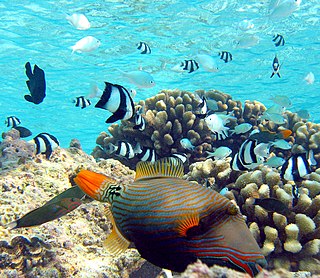
Tropical fish are generally those fish found in aquatic tropical environments around the world. Fishkeepers often keep tropical fish in freshwater and saltwater aquariums. The term "tropical fish" is not a taxonomic group, but rather is a general term for fish found in such environments, particularly those kept in aquariums.

Mote Marine Laboratory is an independent, nonprofit, marine research organization based on City Island in Sarasota, Florida, with additional campuses in eastern Sarasota County, Boca Grande, Florida, and the Florida Keys. Founded in 1955 by Eugenie Clark in Placida, Florida, it was known as the Cape Haze Marine Laboratory until 1967. The laboratory aims to advance marine science and education, supporting conservation and sustainable use of marine resources. A public aquarium and associated education program interpret its research for the public.
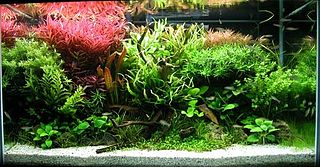
Aquascaping is the craft of arranging aquatic plants, as well as rocks, stones, cavework, or driftwood, in an aesthetically pleasing manner within an aquarium—in effect, gardening under water. Aquascape designs include a number of distinct styles, including the garden-like Dutch style and the Japanese-inspired nature style. Typically, an aquascape houses fish as well as plants, although it is possible to create an aquascape with plants only, or with rockwork or other hardscape and no plants.

Fishkeeping is a popular hobby, practiced by aquarists, concerned with keeping fish in a home aquarium or garden pond. There is also a piscicultural fishkeeping industry, serving as a branch of agriculture.

Aquarium fish feed is plant or animal material intended for consumption by pet fish kept in aquariums or ponds. Fish foods normally contain macronutrients, trace elements and vitamins necessary to keep captive fish in good health. Approximately 80% of fishkeeping hobbyists feed their fish exclusively prepared foods that most commonly are produced in flake, pellet or tablet form. Pelleted forms, some of which sink rapidly, are often used for larger fish or bottom feeding species such as loaches or catfish. Some fish foods also contain additives such as sex hormones or beta carotene to artificially enhance the color of ornamental fish.
SEA LIFE Sydney Aquarium is a public aquarium that features a large variety of Australian aquatic life, displaying more than 700 species comprising more than 13,000 individual fish and other sea and water creatures from most of Australia's water habitats. Opened in 1988, it is regarded as one of Sydney's premier tourist attractions with over 55% of its visitors each year coming from overseas.

Jeanne Villepreux-Power, born Jeanne Villepreux, was a pioneering French marine biologist who in 1832 was the first person to create aquaria for experimenting with aquatic organisms. The English biologist Richard Owen referred to her as the "Mother of Aquariophily." She was the inventor of the aquarium and the systematic application of the aquarium to study marine life, which is still used today. In her time as a forefront cephalopods researcher, she proved that the Argonauta argo produces its own shells, as opposed to acquiring them. Villepreux-Power was also a noted dressmaker, author, and conservationist, as well as the first female member of the Catania Accademia Gioenia.

A public aquarium or public water zoo is the aquatic counterpart of a zoo, which houses living aquatic animal and plant specimens for public viewing. Most public aquariums feature tanks larger than those kept by home aquarists, as well as smaller tanks.

A freshwater aquarium is a receptacle that holds one or more freshwater aquatic organisms for decorative, pet-keeping, or research purposes. Modern aquariums are most often made from transparent glass or acrylic glass. Typical inhabitants include fish, plants, amphibians, and invertebrates, such as snails and crustaceans.

The Goldfish is a freshwater fish in the family Cyprinidae of order Cypriniformes. It is commonly kept as a pet in indoor aquariums, and is one of the most popular aquarium fish. Goldfish released into the wild have become an invasive pest in parts of North America.

An aquarium is a vivarium of any size having at least one transparent side in which aquatic plants or animals are kept and displayed. Fishkeepers use aquaria to keep fish, invertebrates, amphibians, aquatic reptiles, such as turtles, and aquatic plants. The term aquarium, coined by English naturalist Philip Henry Gosse, combines the Latin root aqua, meaning 'water', with the suffix -arium, meaning 'a place for relating to'.
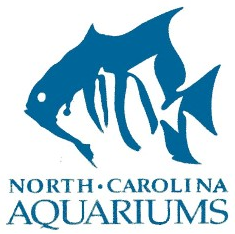
North Carolina Aquariums is a system of three public aquariums located in Kure Beach, Roanoke Island and Pine Knoll Shores. All are operated by the Aquariums Division of the North Carolina Department of Natural and Cultural Resources since 1976 and were accredited by the Association of Zoos and Aquariums. All three aquariums feature dive shows, live animal encounters, and feeding programs.
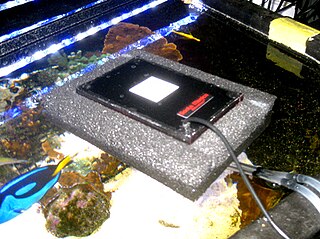
An algae scrubber is a water filtering device which uses light to grow algae; in this process, undesirable chemicals are removed from the water. Algae scrubbers allow saltwater, freshwater and pond hobbyists to operate their tanks using natural filtration in the form of primary production, much like oceans and lakes.

Heather Koldewey is the co-founder of Project Seahorse and head of marine and freshwater for the Zoological Society of London-London Zoo Aquarium. She additionally serves as an honorary professor for University of Exeter and a National Geographic explorer. Her research interests focus on marine and freshwater conservation, seahorse biology and genetics, and the impact of the aquarium trade on wild populations of fish and aquatic invertebrates.
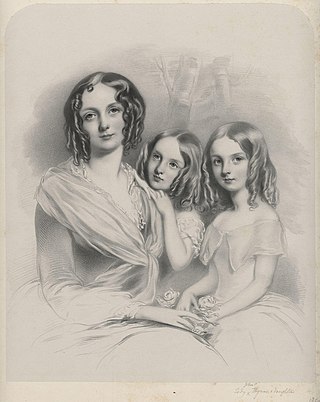
Anna Constantia Thynne, Lady John Thynne was a British marine zoologist. In 1846, she built the first stable and sustained marine aquarium and maintained corals and sponges in it for over three years.

Jennifer (Jennie) Dee Janssen is an aquarist at the National Aquarium in Baltimore, Maryland. Since 2003, she has worked at the Tennessee Aquarium Ripley's Aquarium of the Smokies, Georgia Aquarium, and the National Aquarium, and she is a research associate at the Smithsonian National Museum of Natural History. She is the co-founder of the non-profit organization Minorities in Aquarium and Zoo Science, whose mission is to advance aquarium and zoo science by diversifying the people and perspectives within these fields. She has been recognized with numerous awards including the Top 10 of the Blooloop 50 Zoo & Aquarium Influencer List in 2022.



















